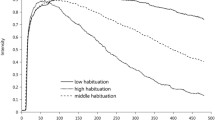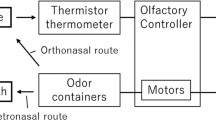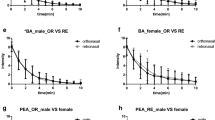Abstract
Introduction
Olfactory habituation results from prolonged exposure to an odor, leading to perceptual changes defined by several characteristics. To date, human habituation research has focused on orthonasal olfaction which is perceived externally while ignoring internal routes of odor perception related to flavor. In our study, we conducted two experiments to characterize retronasal olfactory habituation and measured its impact on flavor perception.
Methods
In Experiment 1, participants were presented a food odor and non-food odor retronasally, using an orally adhered strip. Each participant rated the odor intensity using a time-intensity procedure. After exposure, the participants ate a lime-flavored gummy and rated the lime flavor. In experiment 2, the same procedure was performed for a low-level lime odor, a simple (lime oil) and complex (lime oil + sucrose + citric acid) beverage as the flavor stimuli.
Results
Our results demonstrated two known principles of habituation for retronasally presented odors: (1) prolonged exposure leads to decreased perception and (2) weaker stimuli lead to more rapid habituation. Additionally, we found that the non-food odor habituated slower than the food odor; however, the participants seemed to recover simultaneously upon food and beverage consumption leading to no change in flavor perception.
Conclusion
The findings of this study give evidence that we habituate to different odors at different rates; more specifically, we provide evidence that differentiates between odor origin and concentration.
Implications
This is the first time-intensity characterization of retronasal odor habituation. Additionally, a novel method of administering retronasal odors is presented.




Similar content being viewed by others
References
ASTM International (2017) Standard Guide for Time-Intensity Evaluation of Sensory Attributes. Retrieved from. https://doi.org/10.1520/E1909-13R17
Berglund B, Engen T (1993) A comparison of self-adaptation and cross-adaptation to odorants presented singly and in mixtures. Perception 22:103–111. https://doi.org/10.1068/p220103
Bojanowski V, Hummel T (2012) Retronasal perception of odors. Physiol Behav 107:484–487. https://doi.org/10.1016/j.physbeh.2012.03.001
Cain W (1974) Perception of odor intensity and the time-course of olfactory adaptation. ASHRAE Trans 80:53–75
Cain W, Polak E (1992) Olfactory adaptation as an aspect of odor similarity. Chem Senses 17:481–491. https://doi.org/10.1093/chemse/17.5.481
Chaput MA, Panhuber H (1982) Effects of long duration odor exposure on the unit activity of olfactory bulb cells in awake rabbits. Brain Res 250:41–52. https://doi.org/10.1016/0006-8993(82)90951-9
Chaput MA, Buonviso N, Berthommier F (1992) Temporal patterns in spontaneous and odour-evoked mitral cell discharges recorded in anaesthetized freely breathing animals. Eur J Neurosci 4:813–822. https://doi.org/10.1111/j.1460-9568.1992.tb00191.x
Dalton P (1996) Odor perception and beliefs about risk. Chem Senses 21:447–458. https://doi.org/10.1093/chemse/21.4.447
Dalton P (1999) Cognitive influences on health symptoms from acute chemical exposure. Health Psychol 18:579–590
Dalton P (2000) Psychophysical and behavioral characteristics of olfactory adaptation. Chem Senses 25:487–492. https://doi.org/10.1093/chemse/25.4.487
Dalton P, Dilks D, Ruberte J (1999) Effects of social cues on perceived odor, irritation and health symptoms from solvent exposure. Proc Abs Annu Meet East Psychol Associ 70:135
de Wijk RA (1989) Temporal factors in human olfactory perception. Doctoral dissertation, University of Utrecht
Foster DH (2003) Does colour constancy exist? Trends Cogn Sci. 7(10):439–443
Gagnon P, Mergler D, Lapare S (1994) Olfactory adaptation, threshold shift and recovery at low levels of exposure to methyl isobutyl ketone (MIBK). Neurotoxicology 15:637–642
Gottfried JA (2010) Central mechanisms of odour object perception. Nat Rev Neurosci 11:628–641. https://doi.org/10.1038/nrn2883
Green BG, Dalton P, Cowart B, Shaffer G, Rankin K, Higgins J (1996) Evaluating the “labeled magnitude scale” for measuring sensations of taste and smell. Chem Senses 21:323–334. https://doi.org/10.1093/chemse/21.3.323
Heilmann S, Hummel T (2004) A new method for comparing orthonasal and retronasal olfaction. Behav Neurosci 118:412–419. https://doi.org/10.1037/0735-7044.118.2.412
Hummel T, Sekinger B, Wolf SR, Pauli E, Kobal G (1997) “Sniffin” sticks’. Olfactory performance assessed by the combined testing of odor identification, odor discrimination and olfactory threshold. Chem Senses 22:39–52. https://doi.org/10.1093/chemse/22.1.39
Hummel T, Seo H-S, Pellegrino R, Heilmann S (2016) Electro-olfactograms in humans in response to ortho- and retronasal chemosensory stimulation. Chemosens Percept 10:1–5. https://doi.org/10.1007/s12078-016-9217-z
Kadohisa M, Wilson DA (2006) Olfactory cortical adaptation facilitates detection of odors against background. J Neurophysiol 95:1888–1896. https://doi.org/10.1152/jn.00812.2005
Kobayashi T, Sakai N, Kobayakawa T, Akiyama S, Toda H, Saito S (2007) Effects of cognitive factors on perceived odor intensity in adaptation/habituation processes: from 2 different odor presentation methods. Chem Senses 33:163–171. https://doi.org/10.1093/chemse/bjm075
Köster EP, de Wijk RA (1991) Olfactory adaptation. In: Laing DG, Doty RL, Breipohl W (eds) The human sense of smell. Springer, Berlin, Heidelberg, pp 199–215
Laing DG, Legha PK, Jinks AL, Hutchinson I (2003) Relationship between molecular structure, concentration and odor qualities of oxygenated aliphatic molecules. Chem Senses 28:57–69
Larson-Powers N, Pangborn RM (1978) Descriptive analysis of the sensory properties of beverages and gelatins containing sucrose or synthetic sweeteners. J Food Sci 43:47–51. https://doi.org/10.1111/j.1365-2621.1978.tb09733.x
Leathers TD (2003) Biotechnological production and applications of pullulan. Appl Microbiol Biotechnol 62:468–473. https://doi.org/10.1007/s00253-003-1386-4
Lim J, Johnson MB (2012) The role of congruency in retronasal odor referral to the mouth. Chem Senses 37:515–522. https://doi.org/10.1093/chemse/bjs003
Linster C, Henry L, Kadohisa M, Wilson DA (2007) Synaptic adaptation and odor-background segmentation. Neurobiol Learn Mem 87:352–360. https://doi.org/10.1016/j.nlm.2006.09.011
Mozell MM, Smith BP, Smith PE, Sullivan RL, Swender P (1969) Nasal chemoreception in flavor identification. Arch Otolaryngol Head Neck Surg 90:367–373. https://doi.org/10.1001/archotol.1969.00770030369020
Pellegrino R, Sinding C, de Wijk RA, Hummel T (2017) Habituation and adaptation to odors in humans. Physiol Behav 177:13–19. https://doi.org/10.1016/j.physbeh.2017.04.006
Philpott CM, Wolstenholme CR, Goodenough PC, Clark A, Murty GE (2008) Olfactory clearance: what time is needed in clinical practice? J Laryngol Otol 122:912–917. https://doi.org/10.1017/S0022215107000977
Pierce AM, Simons CT (2018) Olfactory adaptation is dependent on route of delivery. Chem Senses 43:197–203. https://doi.org/10.1093/chemse/bjy007
Rankin CH, Abrams T, Barry RJ, Bhatnagar S, Clayton DF, Colombo J, Coppola G, Geyer MA, Glanzman DL, Marsland S, McSweeney FK, Wilson DA, Wu CF, Thompson RF (2010) Habituation revisited: an updated and revised description of the behavioral characteristics of habituation 92:135–138. doi: https://doi.org/10.1016/j.nlm.2008.09.012.Habituation
Rozin P (1982) “Taste-smell confusions” and the duality of the olfactory sense. Percept Psychophys 31:397–401. https://doi.org/10.3758/BF03202667
Schiet FT, Cain WS (1990) Odor intensity of mixed and unmixed stimuli under environmentally realistic conditions. Perception 19:123–132. https://doi.org/10.1068/p190123
Scott JW, Sherrill L, Jiang J, Zhao K (2014) Tuning to odor solubility and sorption pattern in olfactory epithelial responses. J Neurosci 34:2025–2036. https://doi.org/10.1523/JNEUROSCI.3736-13.2014
Sinding C, Valadier F, Al-Hassani V et al (2017) New determinants of olfactory habituation. Sci Rep 7:41047. https://doi.org/10.1038/srep41047
Small DM, Voss J, Mak YE, Simmons KB, Parrish T, Gitelman D (2004) Experience-dependent neural integration of taste and smell in the human brain. J Neurophysiol 92:1892–1903
Small DM, Gerber JC, Mak YE, Hummel T (2005) Differential neural responses evoked by orthonasal versus retronasal odorant perception in humans. Neuron 47:593–605. https://doi.org/10.1016/j.neuron.2005.07.022
Smith DW, Gamble KR, Heil TA (2010) A novel psychophysical method for estimating the time course of olfactory rapid adaptation in humans. Chem Senses 35:717–725. https://doi.org/10.1093/chemse/bjq073
Stevenson RJ, Boakes RA, Prescott J (1998) Changes in odor sweetness resulting from implicit learning of a simultaneous odor-sweetness association: an example of learned synesthesia. Learn Motiv 29:113–132. https://doi.org/10.1006/lmot.1998.0996
Stevenson RJ, Prescott J, Boakes RA (1999) Confusing tastes and smells: how odours can influence the perception of sweet and sour tastes. Chem Senses 24:627–635. https://doi.org/10.1093/chemse/24.6.627
Stone H, Pryor GT, Steinmetz G (1972) A comparison of olfactory adaptation among seven odorants and their relationship with several physicochemical properties. Percept Psychophys 12:501–504. https://doi.org/10.3758/BF03210944
Stuck BA, Fadel V, Hummel T, Sommer JU (2013) Subjective olfactory desensitization and recovery in humans. Chem Senses 39:151–157. https://doi.org/10.1093/chemse/bjt064
Thompson RF, Spencer WA (1966) Habituation: a model phenomenon for the study of neuronal substrates of behavior. Psychol Rev 73:16–43
Todrank J, Wysock CJ, Beauchamp GK (1991) The effects of adaptation on the perception of similar and dissimilar odors. Chem Senses 16:467–482. https://doi.org/10.1093/chemse/16.5.467
Uchida N, Kepecs A, Mainen ZF (2006) Seeing at a glance, smelling in a whiff: rapid forms of perceptual decision making. Nat Rev Neurosci 7:485–491. https://doi.org/10.1038/nrn1933
Welge-Lussen A, Ebnother M, Wolfensberger M, Hummel T (2009) Swallowing is differentially influenced by retronasal compared with orthonasal stimulation in combination with gustatory stimuli. Chem Senses 34:499–502. https://doi.org/10.1093/chemse/bjp024
Wilson DA (1998) Habituation of odor responses in the rat anterior Piriform cortex. J Neurophysiol 79:1425–1440
Wilson D (2010) Olfactory adaptation. In: Goldstein EB (ed) Encyclopedia of Perception. SAGE, Thousand Oaks, CA, pp 676–679
Yang GC, Scherer PW, Zhao K, Mozell MM (2007) Numerical modeling of odorant uptake in the rat nasal cavity. Chem Senses 32:273–284. https://doi.org/10.1093/chemse/bjl056
Acknowledgements
The authors would like to thank Sara Burns for her work organizing the logistics of the studies.
Author information
Authors and Affiliations
Contributions
C.R.L. and R.P designed the studies, constructed the manuscript and performed the data analysis. J.S., A.A., and S.A. constructed and administered the stimuli and contributed to the manuscript preparation.
Corresponding author
Ethics declarations
Funding
This study had no direct funding sources.
Conflict of Interest
The authors declare that they have no conflict of interest.
Ethical Approval
This study was conducted according to the Declaration of Helsinki for studies on human subjects. The protocol used in this study was approved by the Institutional Review Board of the University of Tennessee (Knoxville, TN).
Informed Consent
Before publication, the experimental procedure was explained to all participants and a written informed consent was obtained from each.
Additional information
Publisher’s Note
Springer Nature remains neutral with regard to jurisdictional claims in published maps and institutional affiliations.
Rights and permissions
About this article
Cite this article
Pellegrino, R., Atchley, A., Ali, S. et al. Retronasal Habituation: Characterization and Impact on Flavor Perception Using Time-Intensity. Chem. Percept. 13, 1–10 (2020). https://doi.org/10.1007/s12078-018-9254-x
Received:
Accepted:
Published:
Issue Date:
DOI: https://doi.org/10.1007/s12078-018-9254-x




